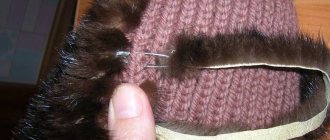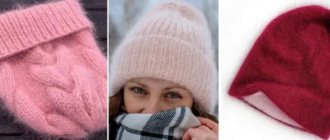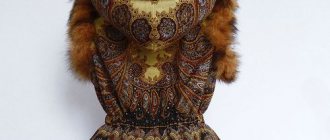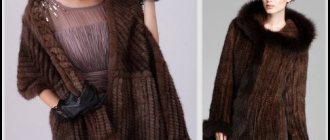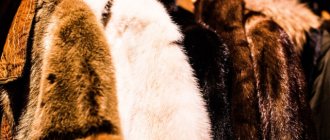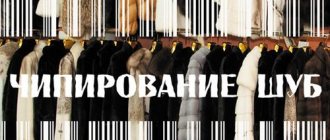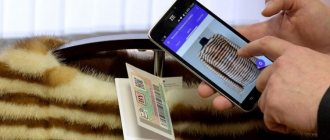Needlewomen made a discovery in the world of knitted art. You can create real masterpieces from fur yarn and you don’t need to have any special skills in home crafts to do this.
Knitting with fur knitting needles was invented in the second half of the 20th century by a fashion designer from Canada, in the past an ordinary housewife. She used the skin of a domestic rabbit. The result of the creative experiment captured the imagination of fashionistas.
Ideas for inspiration
Needlewomen get ideas when they come into contact with mink fur. This valuable material will never go out of style. You can create real exclusive models with your own hands from your grandmother’s old fur coats.
The photo shows the creative finds of the Japanese fashion designer. A mink fur ribbon was threaded into a knitted fabric and the model turned from an ordinary jacket into a warm outing coat.
The video selection presents a chic collection of things knitted from fur. Fashionable models of hats and fur coats are made of fluffy strips of mink, rabbit and silver fox.
FUR IMITATION YARN
Fur has always been popular because fur products are beautiful, pleasant to the touch, practical and warm. Fur can be natural or artificial, depending on the beliefs of its owner or his financial capabilities.
An interesting idea is yarn that imitates fur. It is a thread with long pile sewn to it.
When knitting, a fluffy fur fabric is formed. The pile can be long and short, dense and sparse. This also changes the texture of the knitted fabric.
The color palette is presented very widely - from natural shades typical of animal fur to obviously artificial, bright, provocative tones. For every taste.
The composition of this yarn is mainly synthetic - polyester, polyamide. But some samples contain wool.
In general, yarn imitating fur can be divided into three types:
Firstly, the so-called “grass”. The name, in general, speaks for itself. The knitted fabric is a fluffy “lawn” of thin silky threads, quite long, so that they sway and play when moving.
Secondly, yarn that resembles faux fur or plush. The length, thickness and density of the pile may vary.
Thirdly, yarn that seeks to imitate natural animal fur. It can resemble the fur of mink, rabbit, lynx and other animals. Often this yarn is called “Rabbit (rabbit)”, “Lyns (lynx)”, “Mink (mink)”.
What to choose is a matter of taste. The choice is quite significant.
Probably, at different times, each of the manufacturers produced yarn that imitated fur. Some have abandoned this idea, while others, on the contrary, are offering new samples. Thus, a wonderful collection of models made from faux fur yarn was presented by the Spanish manufacturer Katia for the fall-winter 2016-2017 season.
We have collected a small selection of yarn samples.
Types of yarn imitating fur
Katia Estepa (Spain) 90% polyamide, 10% polyester 95 m / 100 g
Katia Velor (Spain) 80% polyamide, 20% polyester 150 m / 100 g
Katia Eskimo (Spain) 38% polyamide, 28% acrylic, 25% alpaca, 9% merino 90 m / 50 g
Mondial Tundra (Italy) 20% PA microfiber, 80% PL microfiber 150 m / 100 g
Mondial Savanna (Italy) 60% viscose, 40% polyamide 50 m / 50 g
Red Heart Fur (USA) 100% polyester 10 m / 100 g
Lion Brand Fun Fur (USA) 100% polyester 58 m / 50 g
Alize Furlana (Turkey) 45% wool, 45% acrylic, 10% polyamide 40 m / 100 g
For many years, yarn imitating fur from the Spanish manufacturer Lanas Stop has not lost its popularity among Russian buyers. In its line of yarn, “faux fur” occupies a special place and is represented by nine varieties: Raccoon, Seal, Felino, Fox, Coala, Vison, Lyns, Rabbit, Mink.
Lanas Stop Vison (Spain) 95% viscose, 5% polyamide 65 m / 50 g
Lanas Stop Lyns (Spain) 82% viscose, 18% polyamide 33 m / 50 g
Lanas Stop Rabbit (Spain) 97% viscose, 3% polyamide 25 m / 50 g
Lanas Stop Mink (Spain) 82% viscose, 18% Polyamide 33 m / 50 g
Bergere De France Abakan (France) 32% polyester 68% polyamide 42 m / 50 g
Yarnart Rabbit (Türkiye) 100% polyamide 90 m / 100 g
Yarnart Tango (Türkiye) 100% polyamide 80 m / 100 g
King Cole Luxe (UK) 100% nylon 110 m / 100 g
What and how to knit from yarn that imitates fur
This yarn knits quite quickly and easily. Almost all models made from yarn imitating fur are recommended by designers even for beginners. No patterns will be visible on it. Knit stitch, purl stitch, garter stitch - everything you need. As with any other fancy yarn, the rule applies to yarn imitating fur - the simpler the better. All attention is focused on the yarn, it dominates. Therefore, you need to especially think about the style. But the beauty of fancy yarn is that the simplest model knitted from it, thanks to its interesting structure, will look unusual and beautiful. Or you can experiment and enhance the effect of a special yarn with the originality of the style.
This yarn combines well with classic yarn. At the same time, both of them can act only as decoration, or they can be equal partners. For example, yarn that imitates fur can serve as a trim for a collar or hood; it can be used to make the cuffs of a jacket, hat, or trim the edges of a scarf or poncho, while the entire product will be knitted from classic yarn. And, conversely, in a product made from fur imitation yarn, from classic yarn there may be separate details - trims, cuffs, patch pockets. The combination of stripes made of yarn imitating fur and classic yarn looks interesting. The stripes can be either the same width or different.
What can be knitted from yarn that imitates fur? Anything where fur is appropriate. These are clothes, hats, scarves, slippers, bags, interior items and, of course, toys.
The consumption of such yarn, in general, is comparable to ordinary yarn, since loose fabric is knitted from it on large knitting needles (up to 12 mm in diameter), but everything is individual and depends on the yarn itself: it can be either 10 m or 150 m in 100 g, both depending on the knitting density and the model: a hat will obviously need less yarn than a fur coat. For example, for a size 46 vest you will need approximately 5 skeins of Alize Furlana yarn (Turkey) 40 m / 100 g.
We offer a selection of models that use yarn that imitates fur from the manufacturers of this yarn.
Models knitted from yarn imitating fur
Below we offer you models with descriptions, which can be viewed on our website, and without - for inspiration. Descriptions of Katia models in English can be purchased for a symbolic price of $1.5-2 on the website katia.com. If you have difficulties with translation, write - I will help.
Vests knitted from yarn - imitation fur
The vest is made from Katia Estepa yarn in garter stitch.
The vest is made of classic yarn, the front panels are finished with Katia Estepa yarn.
We have a description of this model on our website.
The vest for girls is made of stripes of classic yarn and imitation fur - Fur yarn from Red Heart
The vest is knitted from Alize Furlana yarn, and the wide placket at the bottom and the edging of the armholes are made with an elastic band made from regular yarn.
Lanas Stop Lyns yarn vest
Yarnart Tango yarn vest
Jackets, jackets, cardigans knitted from yarn - imitation fur
The fur coat is knitted from Katia Estepa yarn and regular yarn in stripes
This fur coat is knitted from Red Heart Fur yarn in different colors
Fun Fur grass coat from Lion Brand
And another model from Lion Brand made from Fun Fur yarn - a fluffy bolero. View description
The jacket is made from Katia Velor yarn
The inside of this jacket is knitted with Katia Eskimo yarn
In this model for a baby, the inside of the jacket is knitted from Alize Furlana yarn. View description
A jacket for a girl made from Schachenmayr Mellow yarn is knitted simply in stockinette stitch. View description
The jacket is made from Katia Velor yarn, the bottom placket and sleeve cuffs are ribbed from regular yarn, as is the set of hat and snood.
The collar, cuffs and bottom of the cardigan are knitted from Katia Velor yarn, and the body is made from section-dyed yarn
Jacket with 3/4 sleeves and stand-up collar is entirely knitted from Katia Eskimo yarn
The jacket is made from Katia Velor yarn
Short sleeve jacket in mélange yarn with elements from Katia Estepa yarn
The jacket is made of Katia Velor yarn, the collar is knitted of Katia Estepa yarn - an interesting combination of two types of yarn that imitates fur
Jacket knitted from Mondial Savanna yarn
The cardigan and details on the bag are made from Mondial Savanna yarn
The pullover is knitted from Mondial Tundra yarn in two colors, which are separated from each other by thin contrasting stripes of smooth yarn
The bottom of this top is made from Mondial Tundra yarn
A fur coat for a girl is made from Katia Estepa yarn
Girl's coat is knitted from Katia Velor yarn
The jacket is made from Katia Estepa yarn
Dresses and skirts made of yarn imitating fur
The skirt is knitted from Katia Estepa yarn, and below you can see a capelette, which will successfully make a set with it
The fluffy details of the dress are knitted from Lanas Stop Vison yarn of different shades
Toys knitted from yarn - imitation fur
View description
Cute puppy knitted from Fur yarn from Red Heart
Scarves and snoods knitted from yarn - imitation fur
Scarf knitted in pearl stitch from regular yarn and decorated with elements made from Katia Estepa yarn
Scarf knitted from Katia Estepa yarn
Headband and animal scarf for baby made from Katia Velor yarn
The scarf is knitted from Schachenmayr Mellow yarn, widens towards the middle and tapers towards the ends with fringe. View description
The fluffy elements of this striped set are made from Katia Eskimo yarn
Snood made of two types of fur yarn
We have a description of this model on our website.
In fact, it is a scarf, which is belted with a wide leather belt. The scarf is knitted from Bergere de France Abakan yarn.
View description
Scarf with hood and pockets made of Fur yarn from Red Heart
Hats knitted from yarn - imitation fur
Grass hat
The hat is knitted from Lanas Stop Rabbit yarn.
View description
View description
A hat with earflaps for a girl is knitted from regular yarn, and its inner part is made from Fur yarn from Red Heart
The hat is knitted from Bernat Pipsqueak yarn. The eyes and nose are embroidered with black yarn.
View description
Slippers knitted from yarn - imitation fur
View description
Slippers for the baby are knitted from Fur yarn from Red Heart
View description
Warm and fluffy slippers for adults are knitted from Fur yarn from Red Heart
Ponchos and caplets knitted from yarn, imitation fur
Capelet trimmed with elements of Katia Velor yarn
The fluffy elements of this poncho are made from Katia Eskimo yarn
The fur trim of the bouclé poncho is made from Katia Eskimo yarn
The fur trim of this heathered poncho is made from Katia Estepa yarn
Capelet knitted from Katia Estepa yarn
Capelet made of fur yarn
Bags made of yarn imitating fur
A backpack for a girl is trimmed with elements from Katia Velor yarn
This bag is knitted from Lanas Stop Vison yarn
In conclusion, I would like to show how interesting decoration elements made from yarn imitating fur can look on children's things.
These wonderful sheep are knitted from Alize Furlana yarn.
We have a knitting description for this dress on our website.
print
Description and video of MK for preparing fur skins
Knitting with fur begins with learning the little secrets of working with fluffy material. It is difficult to find ready-made fluffy yarn, and it is not cheap, but it is necessary to prepare the skin for cutting competently and carefully.
Tips for needlewomen:
- There are several preparations that perfectly saturate the flesh and make it possible to cut the skin of a mink or rabbit into a fur strip. Among them are fatty acids Elbomor or Furalastic.
- Among the means at hand, a mixture of a spoonful of glycerin and the white of one egg is suitable. Important! Dyed or hard rattling skin is treated with 1 * 3 (composition and water), natural ordinary leather - 1 * 5.
- Before cutting, the skin is sprayed with the prepared solution from a spray bottle and stretched thoroughly. Then roll it up and leave it in a plastic bag for 1-2 hours.
- To cut, the fur is stretched, a thin line is drawn with a pencil, and with a blade, holding the skin suspended, it is cut into ribbons. The width of the fur strip is from 3 to 8 mm.
- If you need to twist fluffy mink or rabbit yarn into a thin roll, then use an electric drill or mixer from the available tools.
- A video and a detailed master class with tips from a needlewoman will tell you in detail and show you how to make an excellent fur buckle with your own hands at home.
Video: How to make a fur pompom
The video is a simple master class that will show you how to create fluffy balls with your own hands from leftover rabbit fur and use them to decorate any knitted item.
Knitting with fur is a rather labor-intensive and painstaking process that requires special care, but the result is worth the effort. Completely unnecessary, old pieces of fur can turn into real weekend items. They will allow you to save your family budget, create a designer model and always look like the latest fashion.
Read
Tips for choosing yarn for knitting
Knitting hats from mink and rabbit with video tutorial
To figure out how to knit a fur hat, you need to master the techniques in which this painstaking but pleasant creative process is carried out.
Based on practice, it is known that knitting with fur is carried out in two ways - knitting and braiding. Knitting fur yarn from mink or rabbit is carried out as you knit.
The hats, like the photo, are dense and double-sided, and the work of the needlewoman is light and warm to the touch. Fur strips are placed on the face and are secured with loops during the knitting process. You can attach fluffy yarn on the front side, and secure it by knitting on the back.
Knitting with fur gives rise to truly practical models, as in the photo. In winter, these warm and fashionable hats will protect you during the most severe frosts.
A video and detailed master class on embroidering a hat with mink strips will show another original way of using fur yarn and various fluffy leftovers.
The fur thread is woven onto a knitted base. It is necessary to prepare a hat of the desired style, dense, from high-quality non-stretch yarn. It will serve as a frame onto which fur threads will be woven neatly and in one direction.
The hat with ears, as in the photo above, is made of three types of fur ribbons: rabbit, light and dark mink. Using the braiding technique, you can create large ties that are directed in one direction or the other. The photo shows that the broaches are long and the knitting method allows you to make a wide variety of patterns from fur strips.
Fur knitting master class
This master class is suitable for those needlewomen who have old fur items. It’s a shame to throw them away, but there’s nowhere to dispose of them. If you have worn fur hats and collars, we suggest you knit them into a completely new product using step-by-step photos or using video material.
First of all, before starting the master class, you need to prepare the fur. Open the required cut and clean the underside of it with a brush. The brush will help get rid of old glue and dust. Use a comb to comb the fur, removing pellets and other debris.
Using a ruler and marker, draw even stripes on the wrong side, as shown in the photo. It is necessary to cut the fur by weight, so as not to spoil it with a knife. Or place the product on a stool that has a hole in the center. The knife should constantly touch this hole.
The main part or lining can be knitted or crocheted. It is best to use wool yarn for this. If you use knitting needles, then you need to knit an elastic pattern with holes. For the hook, make columns with double crochets and air loops between them. You don't need to make too small holes, otherwise the fur strip simply won't fit through. Align the pieces during the working process and shake off any loose hair. Take one piece and thread it through the hole, then do the same with the other strip. The ends of the strips must be sewn from the inside with a thin needle but strong threads. The photo shows how the product should look from the inside out.
When you have completely filled the base, turn the product right side out, shake it, and comb the fur with a comb. The photo shows what should happen in the end. Thanks to this technique, you can knit or crochet anything. This concludes the master class. By watching the video material that will be in the article, you can clearly see the entire working process of fur knitting.
Important Tips
- The cells of a knitted hat must be at least 5-7 mm.
- Using a pin or tapestry needle, fur yarn is used to braid the warp cells. The longer the pile, the rarer the braiding can be.
- During the process, it is important to ensure that the fluffy thread does not twist and lies in even rows, face up.
- For ease of work, the base is sewn together after braiding all the gaps. To disguise the seam, it is braided at the final stage, and behind it all the edges of the finished product are formed.
- At the end of the work, you need to secure all the ends and brush over the fur surface.
A short video and visual master class will demonstrate an easy way of knitting - braiding. Advice from a craftswoman: at home, fur can be dyed in any fashionable color with hair dye!
Video: Rabbit fur snood
Fur perforation.
Technology is an ideal alternative to fur knitting. The perforation process is not inferior to knitting in terms of labor intensity and time, but the execution process is somewhat different from the previous one. As in the first technology, the furrier plays the main role here - it is he who manually cuts the skins into a certain pattern, and then pushes each one apart, forming empty cells. Unlike knitting with fur, the cells remain empty, and the skins are turned into a finished product, placed on the lining. The result is a kind of graphic design, although the cells themselves are invisible to the naked eye. The obvious advantages of this manufacturing method are the lightness of the item and much lower fur costs compared to a full-fledged fur coat. In addition, such things keep their shape remarkably well.
Fur perforation.
From mink yarn with an elastic band 1 on 1
My favorite knitting pattern for a hat is 1 by 1 rib. And if it is also knitted from mink yarn, the result is simply brilliant! The slightly elongated crown gives the model a stylish and fashionable look. For an average women's hat size you will need: yarn with mink fluff (350m/50g) – 100 grams; knitting needles on fishing line No. 4.5.
Density: 20 p. = 10 cm.
Description of knitting a hat made of mink fluff:
The work is done using 4 main mink threads and 2 stabilizing threads (included with the skein). Cast on 74 sts + 1 st to join into a circle. Knit with an elastic band 1 by 1 approximately 30 cm (= 54 r.). To decrease, transfer stitches onto two long double needles (37 stitches each). Mark the knit stitch in the center of both needles with markers. Continuing to knit the elastic, in the next row, without knitting 3 loops to the marker, we knit them together purlwise with a slant to the right. Next we knit central. knit and 3 stitches together, purl with a slant to the left. We repeat the same on the other knitting needle. Make such decreases in every second row until 12 stitches remain on the cap. We pull them together and secure the end of the thread.
Author: @lena_knits
With an impressive design.


